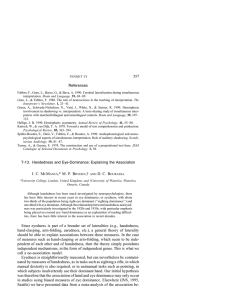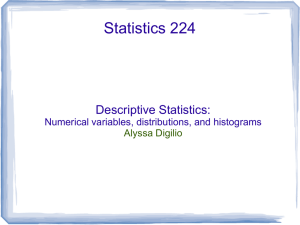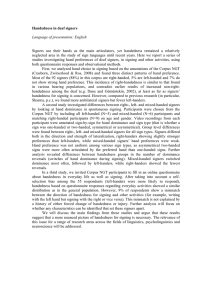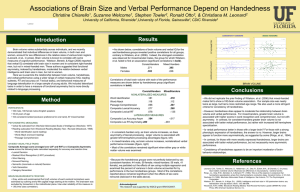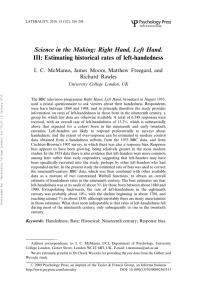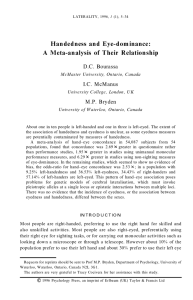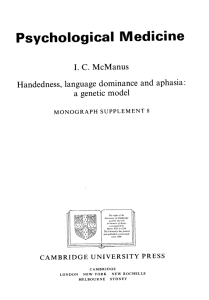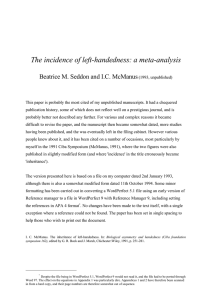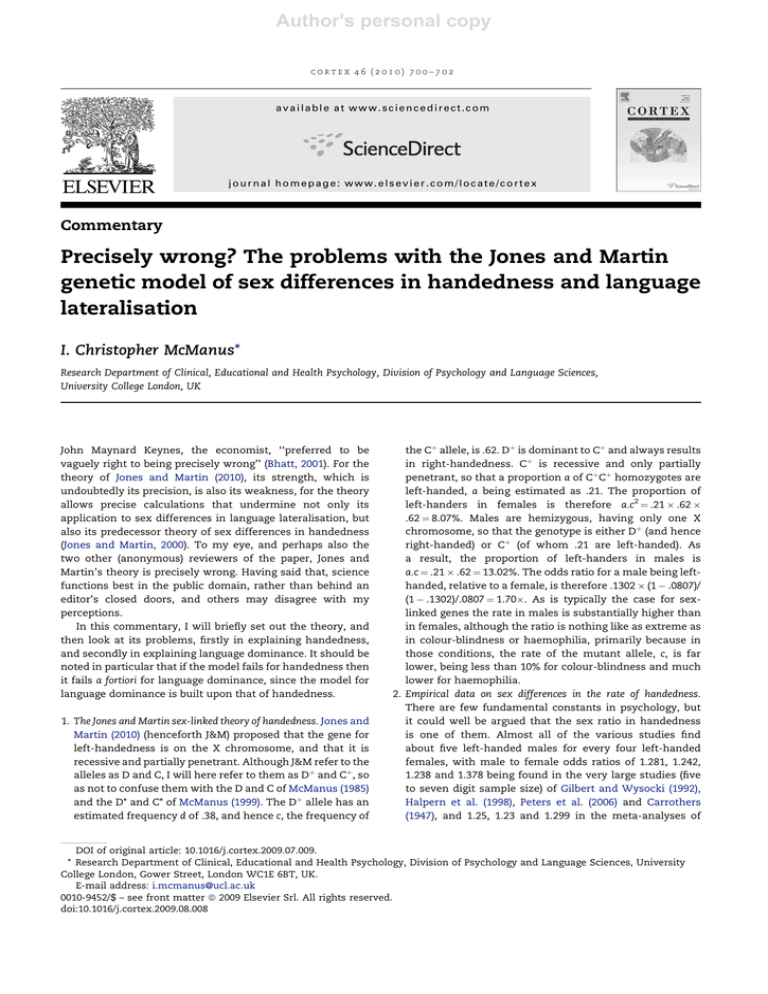
Author's personal copy
cortex 46 (2010) 700–702
available at www.sciencedirect.com
journal homepage: www.elsevier.com/locate/cortex
Commentary
Precisely wrong? The problems with the Jones and Martin
genetic model of sex differences in handedness and language
lateralisation
I. Christopher McManus*
Research Department of Clinical, Educational and Health Psychology, Division of Psychology and Language Sciences,
University College London, UK
John Maynard Keynes, the economist, ‘‘preferred to be
vaguely right to being precisely wrong’’ (Bhatt, 2001). For the
theory of Jones and Martin (2010), its strength, which is
undoubtedly its precision, is also its weakness, for the theory
allows precise calculations that undermine not only its
application to sex differences in language lateralisation, but
also its predecessor theory of sex differences in handedness
(Jones and Martin, 2000). To my eye, and perhaps also the
two other (anonymous) reviewers of the paper, Jones and
Martin’s theory is precisely wrong. Having said that, science
functions best in the public domain, rather than behind an
editor’s closed doors, and others may disagree with my
perceptions.
In this commentary, I will briefly set out the theory, and
then look at its problems, firstly in explaining handedness,
and secondly in explaining language dominance. It should be
noted in particular that if the model fails for handedness then
it fails a fortiori for language dominance, since the model for
language dominance is built upon that of handedness.
1. The Jones and Martin sex-linked theory of handedness. Jones and
Martin (2010) (henceforth J&M) proposed that the gene for
left-handedness is on the X chromosome, and that it is
recessive and partially penetrant. Although J&M refer to the
alleles as D and C, I will here refer to them as Dþ and Cþ, so
as not to confuse them with the D and C of McManus (1985)
and the D* and C* of McManus (1999). The Dþ allele has an
estimated frequency d of .38, and hence c, the frequency of
the Cþ allele, is .62. Dþ is dominant to Cþ and always results
in right-handedness. Cþ is recessive and only partially
penetrant, so that a proportion a of CþCþ homozygotes are
left-handed, a being estimated as .21. The proportion of
left-handers in females is therefore a.c2 ¼ .21 .62 .62 ¼ 8.07%. Males are hemizygous, having only one X
chromosome, so that the genotype is either Dþ (and hence
right-handed) or Cþ (of whom .21 are left-handed). As
a result, the proportion of left-handers in males is
a.c ¼ .21 .62 ¼ 13.02%. The odds ratio for a male being lefthanded, relative to a female, is therefore .1302 (1 .0807)/
(1 .1302)/.0807 ¼ 1.70. As is typically the case for sexlinked genes the rate in males is substantially higher than
in females, although the ratio is nothing like as extreme as
in colour-blindness or haemophilia, primarily because in
those conditions, the rate of the mutant allele, c, is far
lower, being less than 10% for colour-blindness and much
lower for haemophilia.
2. Empirical data on sex differences in the rate of handedness.
There are few fundamental constants in psychology, but
it could well be argued that the sex ratio in handedness
is one of them. Almost all of the various studies find
about five left-handed males for every four left-handed
females, with male to female odds ratios of 1.281, 1.242,
1.238 and 1.378 being found in the very large studies (five
to seven digit sample size) of Gilbert and Wysocki (1992),
Halpern et al. (1998), Peters et al. (2006) and Carrothers
(1947), and 1.25, 1.23 and 1.299 in the meta-analyses of
DOI of original article: 10.1016/j.cortex.2009.07.009.
* Research Department of Clinical, Educational and Health Psychology, Division of Psychology and Language Sciences, University
College London, Gower Street, London WC1E 6BT, UK.
E-mail address: i.mcmanus@ucl.ac.uk
0010-9452/$ – see front matter ª 2009 Elsevier Srl. All rights reserved.
doi:10.1016/j.cortex.2009.08.008
Author's personal copy
cortex 46 (2010) 700–702
Sommer et al. (2008), Papadatou-Pastou et al. (2008) and
Seddon and McManus (1991) [see http://www.ucl.ac.uk/
medical-education/publications/unpublished-manuscripts/
meta-analysis-of-handedness and McManus (1991)]. The sex
ratio also appears to be historically invariant over the past 100
years (McManus, 2009).
3. The fit of the J&M model to the handedness data. PapadatouPastou et al. make clear that, ‘‘the male to female odds
ratio [of] 1.23 (95% confidence interval – CI ¼ 1.19–1.27).
places an important constraint on current theories of
handedness’’. (Papadatou-Pastou et al., 2008). That is
indeed the case, and it is only with much wriggling and
prestidigitation that J&M suggest that 1.23 is compatible
with their prediction of 1.70. J&M suggest that when, ‘‘.
grouping studies by location, the ratio of male to female
left- to right-handedness odds for studies in East Asia
(including Japan and China) was 1.60’’. That value of 1.60
is still short of 1.70 (although it is included in the wide
95% CI of 1.36–1.87). With a median sample size of about
1300, and a maximum of 4282, almost none of these East
Asian studies would individually have had adequate
power for detecting sex differences, making them problematic. J&M also invoke method differences, saying that,
‘‘the observed odds ratio ranged from 1.16 for studies that
simply utilised writing hand to 2.28 for studies that used
the Annett Hand Preference Questionnaire (AHPQ).’’. In
fact of the seven methods described, six had odds ratios
of 1.16, 1.28, 1.28, 1.19 1.17 and 1.20, the only apparent
exception being the 2.28 for the AHPQ, and that perhaps
should not be taken too seriously as it has a 95% CI from
1.07 to 4.86, which of course includes 1.23. At this point I
can do no better than to quote one of the other reviewers
of this paper:
‘‘The answers involve a lot of special pleading, even to
the extent of undermining the findings of [J&M’s] own
meta-analysis of sex differences for handedness. I do
not find the arguments convincing but I believe they
could be offered for wider scientific scrutiny.’’
I presume that J&M would not wish to suggest that their
sex-linked genetic theory only adequately explains studies
in East Asia or studies using the AHPQ. Certainly it does not
seem to explain the vast amount of data collected in the
West using other standard methods.
4. The J&M sex-linked theory of language dominance. The J&M
theory of language dominance follows on from that of
McManus (1984) and Annett (1985) in suggesting that
a single gene controls both handedness and language lateralisation. The novelty is that the gene is on the X chromosome, and hence sex differences are an integral part of
the model. The predictions of the theory are fairly
straightforward. As J&M’s table 1 shows, there is complete
equivalence of minority handedness (left) and minority
language hemisphere (right). Minority hemisphere, in the
population overall, therefore has the same odds ratio for
sex as does minority handedness, i.e., 1.70. In right-handers, though, as J&M’s formula 1 shows, the odds ratio is
somewhat higher at 1.80, whereas in left-handers an
701
identical proportion of males and females have minority
language, giving an odds ratio of exactly 1.
5. The fit of the J&M model to the language dominance data of
Knecht et al. Knecht et al. (2000a, 2000b) reported that 28/113
(24.8%) of left-handers showed right language dominance
compared with 14/188 (7.5%) right-handers, a large difference which is compatible with other studies. J&M’s
predictions fit well with those data (21.0% and 9.3%), but
then so do most other theories.1 Knecht et al. did not report
their left-handed data by sex, and hence J&M’s prediction of
no sex difference cannot be tested. However in male righthanders, 8/77 (10.4%) showed right language dominance
compared with 6/111 (5.4%) females. Although the odds
ratio is 2.029, that difference is not statistically significant
(p ¼ .201), and a bootstrap calculation suggests that the 95%
confidence interval is from .24 to 3.16, the wide range being
expected as there were only 14 individuals in total with
right language dominance. Such data are compatible with
almost any model that can be proposed, and in particular
they are compatible with a null model suggesting no sex
differences. Perhaps the most curious feature of the J&M
study is testing a model that predicts sex differences
against a dataset without significant sex differences, and
then claiming that the data support the model. That sort of
test is no test at all, and it is hardly fair to suggest that
‘‘ultrasonography makes it possible to test this new theory
rigorously, and its parameter-free pattern of predictions is
found to be supported.’’
6. The fit of the J&M model to other data on sex differences in
language dominance. Sex differences in language lateralisation have been controversial for many years, not least since
the high profile paper by Shaywitz et al. (1995). Meta-analyses have been rare, although Voyer (1996) did suggest that
there might be modest sex differences. The systematic
meta-analysis of Sommer et al. (2008) reviewed the available data on sex differences in dichotic listening (DL; 12
datasets, n ¼ 3822) and functional imaging (FI; 26 datasets,
n ¼ 2151), as well as in asymmetries of the planum temporale (PT; 12 datasets, n ¼ 807), which some suggest underpins language dominance. Together those studies have the
statistical power that J&M suggest when they say, ‘‘the
detection of [the sex difference] is expected to need of the
order of a thousand participants’’. In Sommer et al’s metaanalyses, Hedge’s g (which is very similar to Cohen’s d), was
.09 (p ¼ .18), .01 (p ¼ .73)2 and .11 (p ¼ .68), for DL, FI and PT,
respectively. In contrast, the recessive model’s predictions
of 6.9% and 11.8% in right-handers would be equivalent to
a Cohen’s d of .326. Even if there are minor doubts about
1
Care should be taken in interpreting J&M’s statement that,
‘‘Furthermore, the large number of observations [in Knecht’s
studies] meant that the failure to reject the theory could not be
attributed to any lack of power in the test. Instead, power analysis showed that the actual power of detecting a medium-sized
discrepancy from the theory was, according to Cohen (1988),
greater than 99.5%’’. They are describing here only the theory’s
prediction of a greater rate of right language localisation in
left-handers than right-handers, a finding well-known for
a century or more.
2
I have used the values in their figure 4, rather than in the text,
which are presumably a typo.
Author's personal copy
702
cortex 46 (2010) 700–702
particular studies included in the meta-analysis, the
picture overall is clear. There is currently no evidence for
significant sex differences in language lateralisation, and
the values are far removed from J&M’s predictions. The
values for FI (but not DL) are also significantly lower than
the d of .114 that would be expected from the 1.23 odds
ratio found in handedness.
Taken overall, it is difficult to see that the J&M model
succeeds in any of its objectives. It does not adequately
explain the vast majority of data on sex differences in handedness (which undoubtedly exist but are much smaller than
J&M suggest), and it attempts to explain sex differences in
language lateralisation (which are not convincingly present in
the data in the literature). At this point a comment of the third
reviewer of the paper is perhaps apposite: ‘‘My overall
conclusion is that support for the X-linked recessive theory
rests on a very slender foundation. Other theories in the field
are able to explain Knecht’s findings at least as well.’’ To me,
the attempts by J&M to explain away problems in terms of the
data rather than the theory are unconvincing, and reminded
me of the ironic comment by Bertolt Brecht, after the 1953
popular uprising in East Berlin, that, the government should
dissolve the people, and elect another.
Despite my relentless criticism of the J&M model, it should
be said that it is not alone in failing to explain sex differences.
No current genetic model of handedness is entirely satisfactory, each having some strengths, and most explaining the
patterns of handedness in families and in twins, and how
language dominance relates to handedness. For me, what is
most surprising – and it is a reason for studying the J&M model
seriously – is the possibility that sex differences are heterogenous, for while there is undoubtedly an excess of male lefthanders, it is also probable that there are no sex differences in
language lateralisation. Most genetic models have assumed
that any pleomorphic effects of the genes would behave
similarly for handedness and language dominance. If that is
not the case then there is a lot of explaining to do.
Acknowledgments
I am grateful to the other two reviewers of the Jones and Martin
paper for permission to quote from their reviews of that paper,
and for their careful reading of the present manuscript.
references
Annett M. Left, Right, Hand and Brain: The Right Shift Theory. New
Jersey: Lawrence Erlbaum, 1985.
Bhatt VV. Man for all seasons. Economic and Political Weekly, 36:
4470–4472, 2001 Dec 1st–7th.
Carrothers GE. Left-handedness among school pupils. American
School Board Journal, 114: 17–19, 1947.
Cohen J. Statistical Power Analysis for the Behavioral Sciences. 2nd ed.
Hillsdale, NJ: Erlbaum, 1988.
Gilbert AN and Wysocki CJ. Hand preference and age in the
United States. Neuropsychologia, 30: 601–608, 1992.
Halpern DF, Haviland MG, and Killian CD. Handedness and sex
differences in intelligence: Evidence from the Medical College
Admission Test. Brain and Cognition, 38: 87–101, 1998.
Jones GV and Martin M. A note on Corballis (1997) and the
genetics and evolution of handedness: Developing a unified
distributional model from the sex-chromosomes gene
hypothesis. Psychological Review, 107: 213–218, 2000.
Jones GV and Martin M. Language dominance, handedness,
and sex: Recessive X-linkage theory and test. Cortex,
in press. doi:10.1016/j.cortex.2009.07.009, 2010.
Knecht S, Deppe M, Dräger B, Bobe L, Lohmann H, Ringelstein E-B,
et al. Language lateralization in healthy right-handers. Brain,
123: 74–81, 2000a.
Knecht S, Dräger B, Deppe M, Bobe L, Lohmann H, Floël A, et al.
Handedness and hemispheric language dominance in healthy
humans. Brain, 123: 2512–2518, 2000b.
McManus IC. The genetics of handedness in relation to
language disorder. In Rose FC (Ed), Advances in Neurology,
vol. 42: Progress in Aphasiology. New York: Raven Press, 1984:
125–138.
McManus IC. Handedness, Language Dominance and Aphasia:
A Genetic Model. Cambridge University Press, Psychological
Medicine, Monograph Supplement No. 8, 1985.
McManus IC. The inheritance of left-handedness. In Bock GR
and Marsh J (Eds), Biological Asymmetry and Handedness
(Ciba Foundation Symposium 162). Chichester: Wiley, 1991:
251–281.
McManus IC. Handedness, cerebral lateralization and the
evolution of language. In Corballis MC and Lea SEG (Eds), The
Descent of Mind: Psychological Perspectives on Hominid Evolution.
Oxford: Oxford University Press, 1999: 194–217.
McManus IC. The history and geography of human handedness.
In Sommer I and Khan RS (Eds), Language Lateralisation and
Psychosis. Cambridge: Cambridge University Press, 2009:
37–58.
Papadatou-Pastou M, Martin M, Munafò MR, and Jones GV. Sex
differences in left-handedness: A meta-analysis of 144
studies. Psychological Bulletin, 134: 677–699, 2008.
Peters M, Reimers S, and Manning JT. Hand preference for writing
and associations with selected demographic and behavioral
variables in 255,100 subjects: The BBC internet study. Brain and
Cognition, 62: 177–189, 2006.
Seddon B and McManus, IC. The incidence of left-handedness:
A meta-analysis. Unpublished manuscript, 1991.
Shaywitz BA, Shaywitz SE, Pugh KR, Constable RT, Skudlarski P,
Fulbright RK, et al. Sex differences in the functional
organization of the brain for language. Nature, 373: 607–609,
1995.
Sommer IE, Aleman A, Somers M, Boks MP, and Kahn RS.
Sex differences in handedness, asymmetry of the planum
temporale and functional language lateralization.
Brain Research, 1206: 76–88, 2008.
Voyer D. On the magnitude of laterality effects and sex
differences in functional lateralities. Laterality, 1: 51–83, 1996.


